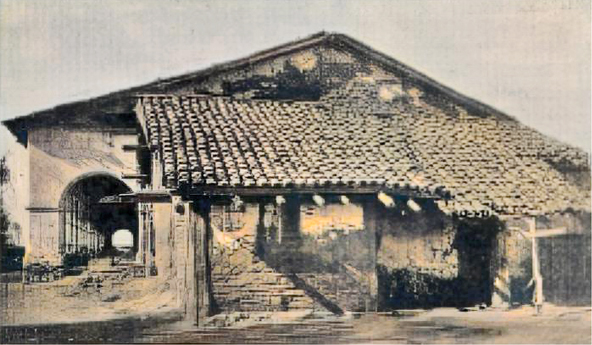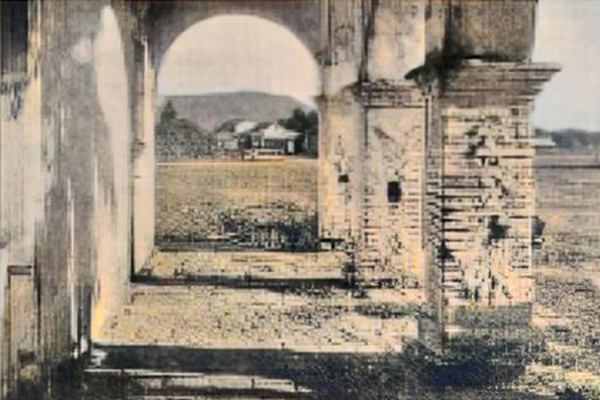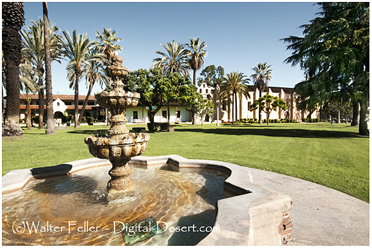The "Asistencia"
California Historical Landmark #4226930 Barton Road, Redlands, CA 92373
Reproduction of the original Estsancia ranch outpost of the Mission San Gabriel
Mission Era (1819 - 1834)

Established in 1819 as a part of the Mission San Gabriel's Rancho San Bernardino, the original Asistencia or more correctly - Estancia functioned as an outpost for cattle grazing activities. The Asistencia buildings we can visit today are reproductions built in the 1930s and located approximately one mile east of the original Estancia site.
It is believed that in 1820 Native Americans began to dig a zanja (irrigation ditch) to serve the area, planned by Pedro Alvarez. At the same time, Carlos Garcia, the Spanish majordomo (overseer) of the Rancho, directed construction of an enramada (bower or arbor) for worship, an adobe administration building with storerooms, and a personal residence. Majordomo Juan Alvarado (1826 - 1834) relocated the Estancia to its present site in 1830, where he constructed a new 14 room complex of adobe and timber. By 1834 the facility was abandoned by the Mission, and the Mexican Decree of Secularization ended mission control in California.
Lugo Era (1842 - 1851)

Brothers Jose del Carmen Lugo, Jose Maria Lugo and Vincente Lugo, along with their cousin Diego Sepulveda, were granted title to the San Bernardino Rancho by the Mexican Governor of California in 1842. Included in the property's inventory were the abandoned Estancia, a grist mill, a tile kiln, and a lime kiln. Jose del Carmen Lugo repaired the rancho structures and resided at the Estancia until 1851.
Mormon Era (1851 - 1857)
Mormons purchased the Rancho San Bernardino from the Lugos in 1851 and established the city and, later, the county of San Bernardino. Bishop Nathan C. Tenney was assigned to oversee agricultural operations and moved into the Estancia with his wife. Mrs. Tenney became a teacher in a newly organized school located in one room of the complex. The Estancia also served as a polling place for the newly organized county. The area became known as the Mission District, or Old San Bernardino.
In 1854, Lewis and Henry Cram established a furniture factory near the Estancia using water from the zanja to power their machinery. For two years they manufactured chairs with cowhide seats, tables, cupboards and bedposts from timber that grew along the zanja and in the foothills.
Barton Era (1857 - 1925)
Dr. Benjamin Barton purchased the Estancia and surrounding lands from the Mormons in about 1859. It is believed that he resided and practiced medicine in the adobe buildings until the completion of his own home, still standing adjacent to the Estancia, in 1867. Materials from the Estancia were removed for use elsewhere, and the adobe buildings gradually deteriorated.
Asistencia Era (1925 - present)
In 1925 the Estancia was only a ruin when the County of San Bernardino, assisted by the San Bernardino County Historical Society, acquired it from the Barton family. The remaining historic materials were removed, and construction of a new six room structure began in 1926 under the direction of Horace P. Hinckley. Construction was completed in 1937 as a combined state (State Emergency Relief Administration, or SERA) and federal (Works Progress Administration, or WPA) relief project.
As had been the case in many early restoration and reconstruction projects, artistic liberties were taken in the design of the new Estancia. The bell tower, a historicized element patterned after the Pala Asistencia, was introduced. Modifications were made to the floor plan to provide exhibit space and a residence for a site manager. This facility opened to the public in 1937 as the "Asistencia." In 1960, it was dedicated as California Historical Landmark #42 as an outstanding example of handcrafted structures of the WPA era. Since that time, under the administration of the San Bernardino County Museums, the "Asistencia" has undergone retrofitting for seismic stability.
Cahuilla Indians of the southern Mojave Desert
Others were baptized at a later time at the San Ysabel Asistencia (later the Franciscan Indian Mission) established in the Santa Ysabel Valley southwest of ...
Vanyume Indians
1819 Asistencia established near Redlands; a large number of Vanyume massacred by Mojave tribe 1826 Vanyume visited by Jedediah Smith 1851 Juan Maria
There was Considerable Legal Trade : Old Spanish Trail
Several groups arrived in 1842, including a party of 40 from Abiquiú, New Mexico , who settled at Agua Mansa and Politana, and a group of 19 families who ...
Chronology of expeditions between New Mexico and California ...
Many of them settled at Politana, which earlier had been founded by Hipolito Espinosa. Santiago Martínez leads 19 families to California. This group is ...

Don Antonio Maria Lugo

Mission San Gabriel